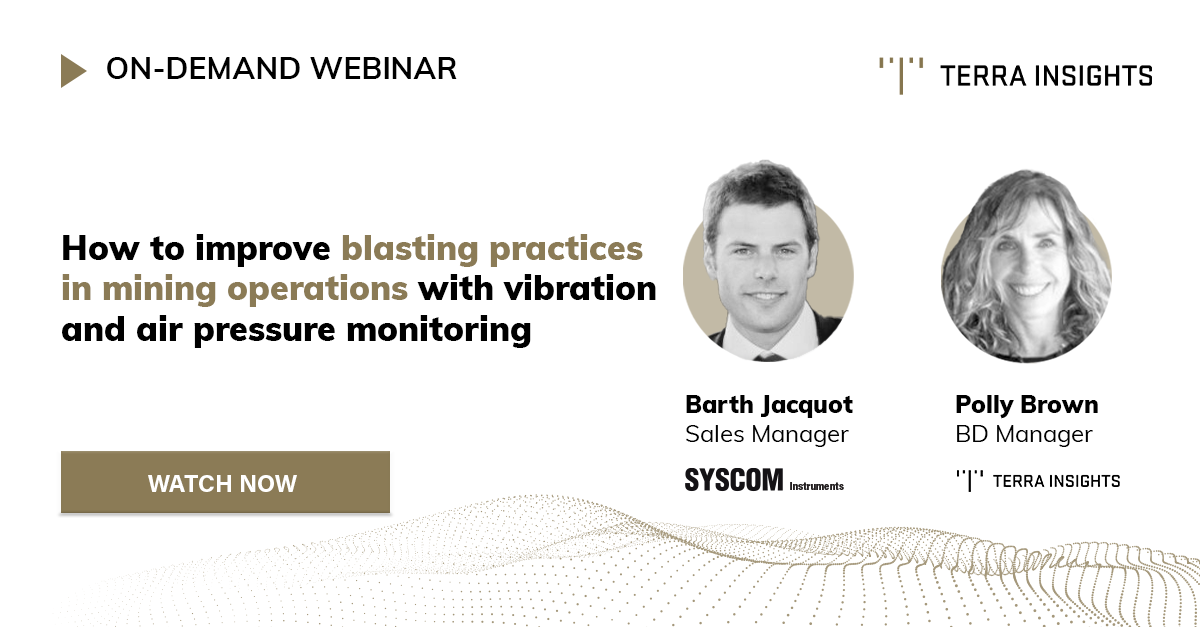Posts by Category
Recent Posts
- In focus: RSTAR Affinity Tilt Logger
- How to Solve Dynamic Structural Health Monitoring Challenges with ROCK Acceleration
- RST Instruments joins leading names in monitoring: Introducing Geosolutions
- Leveraging ShapeArray for wireless automated remote deformation monitoring
- United under Orica Digital Solutions, Terra Insights and GroundProbe merge geotechnical technologies and capabilities
- Terra Insights joins Orica, expanding digital solutions platform
Syscom Instruments’ Barth Jacquot and Terra Insights’ Polly Brown presented How to improve blasting practices in mining operations with vibration and air pressure monitoring, a webinar that detailed how monitoring vibration and air pressure could improve mining practices.
Watch the webinar on-demand to see the entire question and answer section.
The webinar covered:
- How air pressure and vibration monitoring can save cost during mining operations
- How state-of-the-art blasting monitoring systems can help with safety and norms regulatory conformance
- Overview of Syscom’s MR3003BLA and ROCK devices, with Syscom Cloud Software (SCS) with real site examples and installation best practices
- Interactive question and answer session with monitoring experts
We received several questions during the webinar. We’ve included them along with our answers below.
Q: How do you get these sensors calibrated and what is the frequency of calibration?
A: Yes, we were referring to two types of monitoring here. The first one for blast monitoring with the velocity sensor. The velocity sensor is based on geophones that need to be calibrated. Syscom recommends calibration every two years.
As for long-term monitoring, Syscom uses MEMS based acceleration sensors which are very stable over time and do not require recalibration. On site Inspection, occasionally, but no recalibration is required.
We have multiple calibrations centres over the world, one in Chile, one in Canada, one in the United States, one in Australia, and in Europe. You can look at our website to find calibration centres.
Q: The next question is about the ROCK. Where would you use it? And is it possible to try one for a short time prior to getting one?
A: The ROCK is used a lot for infrastructure monitoring and mining applications, when 4G networks are available. I would recommend that you contact one of our partners or Syscom Instruments directly. We will be glad to discuss and provide a demo device.
Q: The next question is regarding underground and surface mining. What are the cost differences between those two, including the blasting and normal mining operations?
A: It highly depends on the mine design, which ore you are extracting and so on. In the end, mining operations are expensive, but it gives, of course, a lot of revenue because it’s highly profitable. But to ensure that the mining operation and the investment that you put in the mine is guaranteed for the whole duration, and to see that the volume of the ore that can be extracted, then you need to do monitoring. You need to have some high-risk analysis, safety structures and processes in place.
Q: So really the equipment would be similar. It’s how it’s deployed and how much is needed, where and obviously in size of mine.
A: Correct, it’s similar in terms of vibration monitoring. I think for underground mining we will go with the MR3003BLA and there are two capabilities of this instrument. One is Wi-Fi connectivity, so if you have underground mines with Wi-Fi. Otherwise, the second, best practice would be called PoE (Power Over Ethernet) you can power this device and bring internet access with only one cable, that would be the recommendation. You need either PoE with a typical LAN cable or Wi-Fi network for underground mining.
Q: How are the thresholds set? And can different units have different thresholds?
A: The thresholds depend if you have to follow a compliance to a standard. The thresholds will be given in the DIN standard, for example. In fact, it’s easy to follow a specific standard because it’s already integrated in the device itself. You can put your own threshold if you want to have two levels—like a warning level, and a not-to-be exceeded level. You can define a threshold that is 80% of the final level and that is automatically calculated by the device. Also, each axis or the three channels—horizontal X, Y, and the vertical axis, which is Z—could also have different threshold levels. It’s versatile, you can modify all the devices, in fact all axis can have different settings.
Q: Another question is about the portability of the units. Can they be used in different locations? Maybe for blasts on the same day in different spots?
A: It depends really what you are willing to do. We’ve seen some permanent installations with concrete, pedestal, solar panels and so on for long-term monitoring, but you have a battery pack that allows you to bring the device back and forth in a very swift manner. So, that would be my recommendation, get a carrying case, or use the ROCK device with the battery pack for a single blast monitoring.
Q: Another question about the locating of the modules, is there a GPS module incorporated in the ROCK?
A: There are no GPS modems incorporated in the ROCK because when you are indoors, the GPS is hard to use. Normally, we use the GPS for time synchronization because you want to have accurate timing to understand how the vibrations will propagate in the mine site. For the ROCK, you need a couple of milliseconds time accuracy provided by using an NTP protocol (Network Time Protocol). For the MR3003BLA, you can plug in GPS antenna which will give you absolute time synchronization.
Q: As far as integrating data from InSAR and vibration, I know that GeoExplorer we can look at both, but do you have any Insight on how those two can work together?
A: You will have high dynamic vibration monitoring in signal acquisition with the blasting devices. You will have real-time information. With InSAR you will get less updates, weekly or daily updates on the InSAR and the analysis of the mine. With InSAR you will have a large scope large scale of the mine sites and displacement, but with the vibration monitoring, it could be a good complementary measurement based on the InSAR global picture to locate the different devices may be close to the areas of concern around the mines. That would be the different approaches with InSAR technologies, geospatial, radar and dynamic vibration.
Q: What about using the vibration data that these sensors collect with other software available?
A: Syscom believes in Open Data Access. You can easily convert the data from the Syscom Data Logger into ASCII file format, where you can process these files and upload them in multiple software types. This is something that we are open to—helping our clients to integrate with Syscom into their own platforms as well.
This transcript has been edited for clarity. Watch the webinar on-demand to learn how vibration and air pressure monitoring can improve blasting practices.
Speak with an Expert
I’m very happy with the quality of the instrumentation and technical support from RST, as always. They worked with us from the initial stages of the project to ensure that we were fully prepared and equipped to use the RSTAR network for the first time. They delivered everything within the tight project time frame to ensure that there were no delays on site, and the submersible tilt meters looked like new even after over twelve months of being submerged in Thames water!
-Richard Lipscombe, BEng (Hons), Director & Principle Consultant - RL Geotechnical Ltd
Related Posts
Terra Insights joins Orica, expanding digital solutions platform
We have some exciting news to share. We are proud to announce that Terra Insights will joi...








